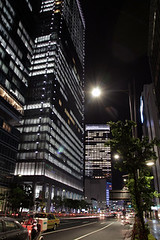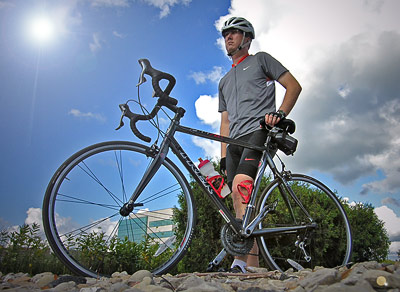
Mike and his Road bike. What? You don't recognize me?
I'll preface my comments regarding the Pheasant Branch Conservancy creek corridor trail by stating I'm an avid on-road and off-road bicyclist. I have a TREK road bicycle (pictured above) for exercise & recreation and a Schwinn hybrid for commuting and light trail duty. I'm also an avid birder and amateur ornithologist. While I'm a far cry from being anti-bicycle, I am staunchly pro-safety and pro-environment. As such, I'm sensitive to the sentiment recently expressed by Steve Leo, Middleton District 8 alderman, who was quoted in the Middleton Times Tribune saying, "Everyone here, myself included, has a carbon footprint the size of Bigfoot...we've got to do something to get folks out of their cars."
On at least one particular point, Steve and I are in agreement: it sure would be nice for more people to commute via bicycle, as we both do. Somebody has to get the green campaign rolling sometime, so it might as well begin with a trail for bicyclists that just so happens to run through one of the best places in southern Wisconsin to observe neotropical migratory songbirds. If we don't stop global climate change, birds will indeed suffer. What's the point of having any sort of nature trail if we allow the world and its critters to succumb to the destructive effects of climate change? There's a flip-side, however. Presently, the greatest cause of declines in bird populations is habitat loss and fragmentation, not global climate change. However, the latter is a deadly threat looming in the future for all the world's living things.
Having heated up the rhetoric with his torrid premise, Steve then attempts to redefine the argument (he is a politician, after all). In the Tribune article he goes on to say, "You purge bikes from the Pheasant Branch Conservancy forever, and our changing climate in the coming years will affect the Pheasant Branch wildlife." Could bicycling through Pheasant Branch really play such a pivotal role on its climate? One wonders just how many bicyclists Steve would like to see using the trails at Pheasant Branch Conservancy in order to circumvent this cataclysmic disaster. First of all, nobody I know, myself included, is calling for a ban on all bicycles from conservancy trails. Heck, I ride my hybrid bike on it all the time. Secondly, while it's certainly admirable to initiate an example for others to follow, it is truly naive to think Americans are anywhere close to ending their love affair with automobiles. If we don't start preserving more breeding and migration stopover habitat now, we won't have to worry about saving birds from global climate change in the future.
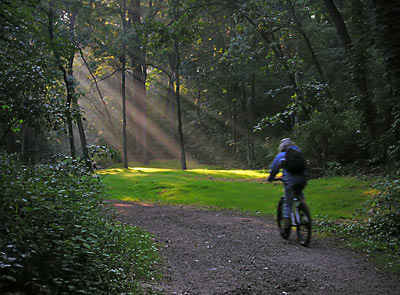
Enjoying the scenic commute via trail bicycle.
What Middleton's politicians seem to keep missing is an appreciation for the diversity of songbirds that use the creek corridor as a migratory pit stop. This is an important point, but no matter how many times I've presented it to Middleton, they just don't seem to appreciate how unusual it is to have over 30 different warbler species foraging in an urbanized natural area in May and September:
Blue-winged Warbler
Golden-winged Warbler
Tennessee Warbler
Orange-crowned Warbler
Nashville Warbler
Northern Parula
Yellow Warbler
Chestnut-sided Warbler
Magnolia Warbler
Cape May Warbler
Black-throated Blue Warbler
Yellow-rumped Warbler
Black-throated Green Warbler
Blackburnian Warbler
Yellow-throated Warbler
Pine Warbler
Palm Warbler
Bay-breasted Warbler
Blackpoll Warbler
Cerulean Warbler
Black-and-white Warbler
American Redstart
Prothonotary Warbler
Worm-eating Warbler
Ovenbird
Northern Waterthrush
Louisiana Waterthrush
Kentucky Warbler
Connecticut Warbler
Mourning Warbler
Common Yellowthroat
Hooded Warbler
Wilson's Warbler
Canada Warbler
There's an enormous educational potential and tourism opportunity being missed; keep the creek corridor wild for the wildlife. Sustain it in the spirit of Aldo Leopold's land ethic as a bird & wildlife sanctuary than merely another well-groomed commuter trial. There are simply not that many places left in Wisconsin where so many different bird species can be observed in a relatively small area in such a short period of time. Though not as critical for nesting habitat by neotropical migratory birds, the creek corridor provides an excellent stopover point for them to rest and refuel for the next leg of their arduous journey. Over two hundred bird species can be observed at Pheasant Branch Conservancy; birds that spend winters in the Amazon Jungle; birds that nest in remote corners of the Boreal Forests in Canada. Isn't anyone else even remotely amazed by this!?
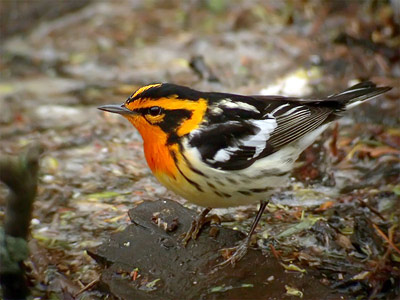
Blackburnian Warbler foraging along the creek corridor.
Does a sanctuary for wildlife exclude children, handicapped individuals, or bicyclists? The answer is a resounding 'no.' But is it necessary to despoil a trail so that the least advantaged among us can safely use it? Where else do we see this "for everyone" philosophy in public operation? Baseball diamonds? Swimming pools? Playground equipment? Contrary to some comments I received through my blog, children presently do just fine bicycling along the existing gravel trail. I have also observed people who are confined to wheelchairs use the trail and the only trouble I've witnessed them experience were at stream crossings (thankfully, the bridges will solve that problem). Will it be easier for them if paved? Sure, of course. But I wonder how comfortable Middleton's politicians will feel by exposing children and handicapped people to road bicyclists who are capable of reaching speeds in excess of 20mph on paved trails with blind corners.
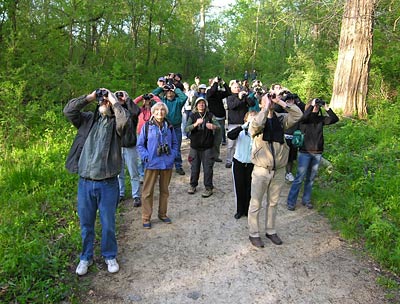
There will be no more of this, my fellow birders!
I understand it's a grant from the Department of Transportation, but it's my opinion that widening and paving the creek corridor trail from Parmenter Street to Century Avenue will be a mistake and waste of money; money better spent on planting more native plants and shrubs on restored areas along the creek corridor, as well as stabilizing the stream bank from ongoing erosion. The existing gravel trail is more than suitable for accommodating popular mountain and hybrid style trail bikes. While birding, I have conducted dozens of interviews with other trail users; joggers, pedestrians, and other birders. They overwhelmingly prefer the gravel trail the way it presently is. Paving it is unpopular. Paving it is unnecessary. Paving the trail will open it to road bicycles, which are capable of going much faster than trail bicycles. Birding along the Capital City trail near Nine Springs (which is paved and serves as a model for the proposed trails in Middleton) can be a very nerve-racking experience on pleasant days when there is increased bicycle traffic.
As someone who spends nearly every morning and evening birding along the creek corridor trail for several hours at a time during migration, I'm concerned not only for myself, but also for my friends. It will be much more difficult for us while looking up into the trees with our binoculars to hear approaching bicyclists on a paved trail. My hearing is fine, but others I know who go there to bird are hearing impaired. Paved, though less of a concern, conducting nature photography will be substantially more difficult due to increased traffic. Paved, there's a greater chance recently fledged birds (and amphibians, mammals, etc.) that wander onto the trail will be severely injured or killed. As traffic has increased on the trail I'm finding more and more squashed frogs and toads during spring. Perahps worst of all, paved, it seems very likely to increase the probability of a pedestrian/bicycle collision around blind corners.
Mike McDowell
Addendum 08/05/2009:
On 08/04/2009, Middleton Common Council voted 6 to 2 in favor of awarding the contract to install the bridges at the remaining stream crossings and pave the trail (from Parmenter Street to Century Avenue).
All images © 2009 Mike McDowell






